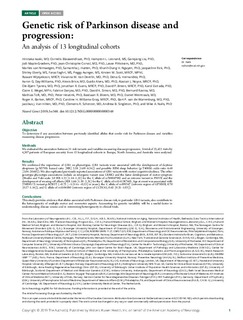| dc.contributor.author | Iwaki, Hirotaka | |
| dc.contributor.author | Blauwendraat, Cornelis | |
| dc.contributor.author | Leonard, Hampton L. | |
| dc.contributor.author | Liu, Ganqiang | |
| dc.contributor.author | Maple-Grødem, Jodi | |
| dc.contributor.author | Corvol, Jean-Christophe | |
| dc.contributor.author | Pihlstrøm, Lasse | |
| dc.contributor.author | van Nimwegen, Marlies | |
| dc.contributor.author | Hutten, Samantha J. | |
| dc.contributor.author | Nguyen, Khanh-Dung H. | |
| dc.contributor.author | Rick, Jacqueline | |
| dc.contributor.author | Eberly, Shirley | |
| dc.contributor.author | Faghri, Faraz | |
| dc.contributor.author | Auinger, Peggy | |
| dc.contributor.author | Scott, Kirsten M. | |
| dc.contributor.author | Wijeyekoon, Ruwani | |
| dc.contributor.author | van Deerlin, Vivianna M. | |
| dc.contributor.author | Hernandez, Dena G. | |
| dc.contributor.author | Day-Williams, Aaron G. | |
| dc.contributor.author | Brice, Alexis | |
| dc.contributor.author | Alves, Guido Werner | |
| dc.contributor.author | Noyce, Alastair J. | |
| dc.contributor.author | Tysnes, Ole-Bjørn | |
| dc.contributor.author | Evans, Jonathan R. | |
| dc.contributor.author | Breen, David P. | |
| dc.contributor.author | Estrada, Karol | |
| dc.contributor.author | Wegel, Claire E. | |
| dc.contributor.author | Danjou, Fabrice | |
| dc.contributor.author | Simon, David K. | |
| dc.contributor.author | Ravina, Bernard | |
| dc.contributor.author | Toft, Mathias | |
| dc.contributor.author | Heutink, Peter | |
| dc.contributor.author | Bloem, Bastiaan R. | |
| dc.contributor.author | Weintraub, Daniel | |
| dc.contributor.author | Barker, Roger A. | |
| dc.contributor.author | Williams-Gray, Caroline H. | |
| dc.contributor.author | van de Warrenburg, Bart P. | |
| dc.contributor.author | van Hilten, Jacobus J. | |
| dc.contributor.author | Scherzer, Clemens R. | |
| dc.contributor.author | Singleton, Andrew B. | |
| dc.contributor.author | Nalls, Mike A. | |
| dc.date.accessioned | 2020-02-13T12:03:43Z | |
| dc.date.available | 2020-02-13T12:03:43Z | |
| dc.date.created | 2019-11-17T14:37:14Z | |
| dc.date.issued | 2019-08 | |
| dc.identifier.citation | Neurology: Genetics. 2019, 5 (4), 1-14. | nb_NO |
| dc.identifier.issn | 2376-7839 | |
| dc.identifier.uri | http://hdl.handle.net/11250/2641538 | |
| dc.description.abstract | Objective To determine if any association between previously identified alleles that confer risk for Parkinson disease and variables measuring disease progression.
Methods We evaluated the association between 31 risk variants and variables measuring disease progression. A total of 23,423 visits by 4,307 patients of European ancestry from 13 longitudinal cohorts in Europe, North America, and Australia were analyzed.
Results We confirmed the importance of GBA on phenotypes. GBA variants were associated with the development of daytime sleepiness (p.N370S: hazard ratio [HR] 3.28 [1.69–6.34]) and possible REM sleep behavior (p.T408M: odds ratio 6.48 [2.04–20.60]). We also replicated previously reported associations of GBA variants with motor/cognitive declines. The other genotype-phenotype associations include an intergenic variant near LRRK2 and the faster development of motor symptom (Hoehn and Yahr scale 3.0 HR 1.33 [1.16–1.52] for the C allele of rs76904798) and an intronic variant in PMVK and the development of wearing-off effects (HR 1.66 [1.19–2.31] for the C allele of rs114138760). Age at onset was associated with TMEM175 variant p.M393T (−0.72 [−1.21 to −0.23] in years), the C allele of rs199347 (intronic region of GPNMB, 0.70 [0.27–1.14]), and G allele of rs1106180 (intronic region of CCDC62, 0.62 [0.21–1.03]).
Conclusions This study provides evidence that alleles associated with Parkinson disease risk, in particular GBA variants, also contribute to the heterogeneity of multiple motor and nonmotor aspects. Accounting for genetic variability will be a useful factor in understanding disease course and in minimizing heterogeneity in clinical trials. | nb_NO |
| dc.language.iso | eng | nb_NO |
| dc.publisher | Wolters Kluwer Health, Inc. | nb_NO |
| dc.rights | Attribution-NonCommercial-NoDerivatives 4.0 Internasjonal | * |
| dc.rights.uri | http://creativecommons.org/licenses/by-nc-nd/4.0/deed.no | * |
| dc.subject | nevrologi | nb_NO |
| dc.subject | Parkinson | nb_NO |
| dc.title | Genetic risk of Parkinson disease and progression: An analysis of 13 longitudinal cohorts | nb_NO |
| dc.type | Journal article | nb_NO |
| dc.type | Peer reviewed | nb_NO |
| dc.description.version | publishedVersion | nb_NO |
| dc.rights.holder | Copyright © 2019 The Author(s). | nb_NO |
| dc.subject.nsi | VDP::Medical disciplines: 700::Clinical medical disciplines: 750::Neurology: 752 | nb_NO |
| dc.source.pagenumber | 1-14 | nb_NO |
| dc.source.volume | 5 | nb_NO |
| dc.source.journal | Neurology: Genetics | nb_NO |
| dc.source.issue | 4 | nb_NO |
| dc.identifier.doi | 10.1212/NXG.0000000000000348 | |
| dc.identifier.cristin | 1748394 | |
| cristin.unitcode | 217,8,10,0 | |
| cristin.unitname | Institutt for kjemi, biovitenskap og miljøteknologi | |
| cristin.ispublished | true | |
| cristin.fulltext | original | |
| cristin.qualitycode | 1 | |

